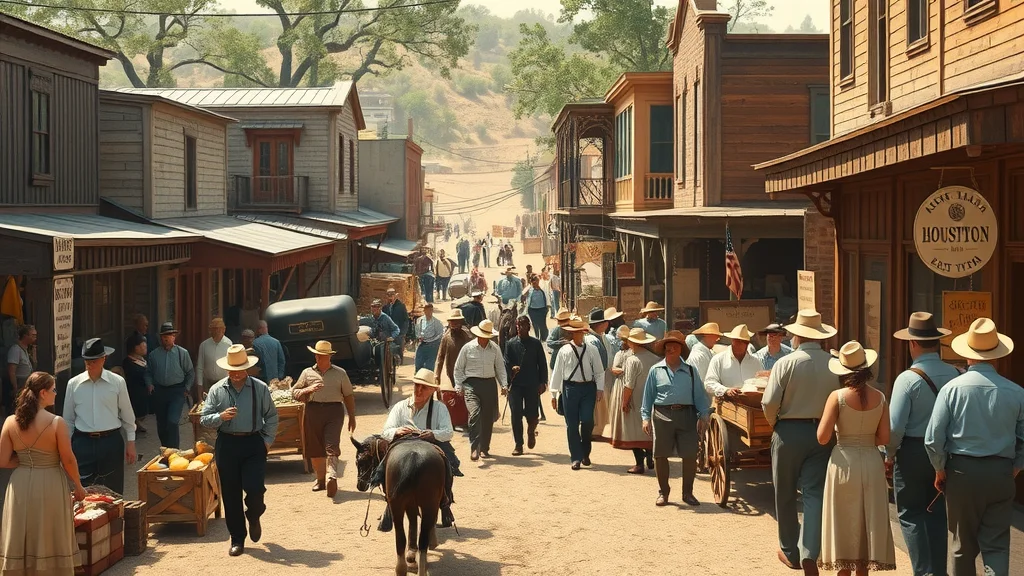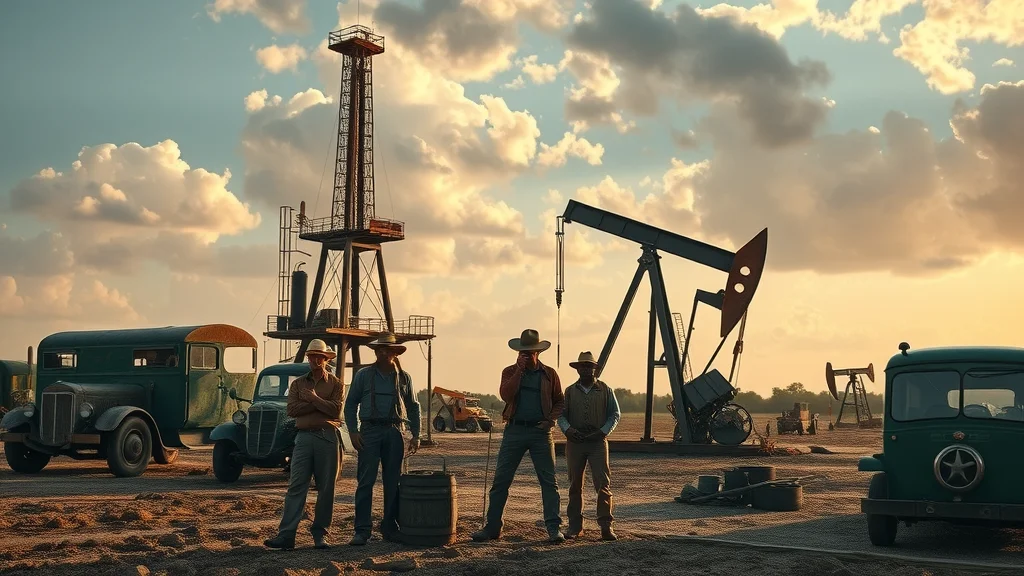Did you know Houston was once the capital of the Republic of Texas, rising from muddy bayou banks to become the nation’s fourth-largest city in less than 200 years? The history of Houston Texas is a story of bold dreams, remarkable transformations, and thriving diversity. In this comprehensive exploration, we’ll uncover the fascinating milestones, pivotal events, and people who shaped Houston from its rugged founding days to its modern skyline.
An Astonishing Look at the History of Houston Texas
- Fact: The city of Houston was founded in 1836 on land near Buffalo Bayou, purchased for just over $5,000—an investment that led to the rise of one of America’s great multicultural hubs.
The history of Houston Texas is one filled with surprising twists and unique triumphs, stretching from its early beginnings as a muddy outpost to a center of medical, technological, and cultural achievement. Whether you’re a longtime resident of the Houston area, a new arrival, or simply curious about one of the nation’s fastest-growing cities, understanding Houston’s past is key to appreciating its present and future. Featuring significant influences from the Republic of Texas, major developments in energy and healthcare, and stories of resilience through hurricanes and conflicts like World War II, Houston’s legacy continues to shape the region and the country at large.

What You'll Learn About the History of Houston Texas
- Key timelines and critical moments in Houston’s development
- Cultural milestones and the shaping of diverse communities
- Notable historical figures like the Allen brothers, Sam Houston, and pioneers of the Texas Medical Center
- How Houston’s growth influenced the national landscape, from the oil boom to the space center innovations
Early Beginnings of Houston Texas
Origins and Founding: From Republic of Texas to Early Settlements
- The story begins in 1836—just as the Republic of Texas secured its independence from Mexico, two ambitious entrepreneurs, Augustus and John Allen, purchased land along Buffalo Bayou.
The history of Houston Texas is rooted in enterprise and opportunism. The Allen brothers envisioned a city at the crossroads of commerce and politics. Their foresight led to the founding of Houston city, named in honor of General Sam Houston, a hero of the Battle of San Jacinto and the first president of the Republic of Texas. The city’s strategic location near Buffalo Bayou allowed easy access to trade routes and fueled its early expansion.
By 1837, with its muddy roads and hastily constructed buildings, Houston became the temporary capital of the Republic of Texas. Early settlers faced immense challenges: periodic floods from Buffalo Bayou, thick forests, and swarms of mosquitoes. Yet, the bustling spirit prevailed, paving the way for municipal government under the first city council. The city’s initial population reflected a mix of traders, ranchers, and visionaries hopeful for growth. Over time, Houston’s proximity to trading routes, the presence of river traffic, and a supportive Texas Congress ensured its survival and gradual prosperity.

"Houston is unique among America's great cities for having been founded in a muddy marsh on a handshake." – Texas Historical Association
Houston’s Growth in the 19th Century
Key Developments Leading into Statehood
- By the mid-1800s, Houston city grew as a bustling trading center. The launch of the Buffalo Bayou, Brazos & Colorado Railway in the 1850s turned Houston into a critical railroad hub, making the city an essential gateway for goods between East Texas and the rest of the nation.
New trade routes accelerated urbanization, leading to the rise of textile and lumber industries. As the population increased, so did infrastructure with bridges, wharves, and improved roads. The formation of the first public schools and the municipal government showed Houston’s adaptability. The influence of the nascent oil companies was already taking root, alongside the beginnings of a city poised for much broader influence.
By the late 1800s, Houston area was steadily integrating new waves of immigrants. The region’s industrial base expanded around the Houston ship channel, even before its full official opening in the early 20th century. By the time Texas joined the United States, the cultural and economic shifts established Houston as one of the key urban leaders in the state, vying with San Antonio and other cities for prominence.

Immigration and Diversity in Early Houston City
- From the late 19th century, Houston’s identity was shaped by diverse communities: Europeans seeking farmland, freed African Americans after the Civil War, and a growing Hispanic population.
As the city grew, so did contributions from different cultures. German, Czech, Jewish, and Italian settlers brought new businesses, churches, and traditions. African American residents advanced in education and established their own neighborhoods and institutions, adding to the fabric of the city. Hispanic families, with roots in both Texas and Mexico, played pivotal roles in labor, commerce, and cultural exchange. Diverse communities helped to define the culture and history of Houston Texas, a character visible in its modern schools, cuisine, and annual festivals.
This collective growth placed Houston firmly on the map, not just as a regional trading outpost, but as a dynamic multicultural city ready to take on the challenges of the next century.
| Year | Houston | San Antonio | Dallas |
|---|---|---|---|
| 1836 | Founded by Allen brothers | San Antonio integral in Texas Revolution | Settlement begins |
| 1846 | Becomes county seat of Harris County | Annexed by the U.S. | Dallas County formed |
| 1853 | Railroad expansion boosts economy | First English-language school | Incorporated as city |
| 1891 | Buffalo Bayou improvement begins | Streetcar suburbs develop | Electric streetcars introduced |
Houston Texas in the Early 20th Century
Boom Times: Oil, Railroads, and the Texas Medical Center
- Discovery of oil at Spindletop sparked an economic boom, drawing oil companies and expanding the city’s profile nationwide.
The early 1900s marked explosive growth, as oil discoveries near Houston led to the establishment of refineries, pipelines, and new jobs. The Houston ship channel deepened and widened, allowing for the rise of a world-class port and major shipping hub. As railroads and highways converged, Houston became a true crossroads for commerce. The founding of the Texas Medical Center during the 1940s, coupled with the establishment of Rice University and the University of Houston, positioned Houston city as a leading destination for science, medical innovation, and education.
The city also modernized with new public works—the development of Hermann Park, improved public transportation, and neighborhoods like the Heights—setting the scene for subsequent economic and cultural achievement. This period in the history of Houston Texas is remembered for its innovative spirit and large-scale ambition, laying the foundation for the global city Houston would soon become.

World War I and the Interwar Period
- Houston city’s factories, railroads, and ship channel played a vital role in supporting World War I, and the community’s activism set the stage for upcoming social change.
The arrival of World War I brought new jobs and population influx. Shipyards manufactured vessels for military use, and the Houston ship channel became vital for wartime logistics. The city expanded public health initiatives and built hospitals and schools, furthering the mission of the growing Texas Medical Center. After the war, Houston continued to modernize—city council planning steered the city through the Roaring Twenties, with burgeoning neighborhoods and cultural centers like the Alley Theatre and new city parks.
Social impacts were just as profound. The city’s different communities contributed to a unique, blended culture, while women and minorities increasingly participated in civic life. As racial tensions and labor disputes flared across the South, Houston forged ahead with a growing emphasis on education, infrastructure, and diversification—preparing the city for the momentous decades ahead.
World War II and Its Impact on Houston Texas
Houston City’s Wartime Transformation
- During World War II, the city underwent dramatic changes—factories ramped up to produce war materials, and shipyards constructed vessels supporting the national effort.
The need for rapid production brought thousands to Houston city, nearly doubling its population by the end of the war. Shipyards along the Houston ship channel worked around-the-clock, with women joining the workforce in unprecedented numbers. Industrial expansion also led to rapid advances in the Texas Medical Center, where research and patient care for war casualties laid the foundation for Houston’s emergence as a global medical leader.
The pressures of World War II sparked transformative demographic shifts—new neighborhoods and schools developed near shipyards and factories, reshaping the urban core. Houston’s role as a leading port and manufacturing center was secured, propelling a postwar boom and entrenched influence on national policy and economy.

Houston After the War: Economic and Social Growth
- Returning veterans brought skills and aspirations. Federal investment fueled hospital expansions and the growth of the Texas Medical Center, heralding a new era of energy and medical leadership.
The city experienced some of its fastest growth after World War II. Veterans returned to pursue careers fueled by the G.I. Bill and found work in booming energy, medical, and shipping sectors. The Texas Medical Center rapidly advanced cancer care, cardiology, and transplant research, building a global reputation.
The city’s leaders ensured investment in new suburbs and public services—from improved highways to libraries—making Houston city a magnet for families seeking opportunity. By the late 1950s and early 1960s, Houston was indisputably on the path to becoming a world city, with civic pride and an unshakable sense of possibility.
"Houston seemed to reinvent itself overnight, driven by wartime needs and postwar aspirations." – Local historian
Rise of Modern Houston: Space Center, Energy, and Medical Expansion
Space Center Houston and America’s Space Race
- In 1961, NASA’s Manned Spacecraft Center—now Johnson Space Center—opened, instantly elevating Houston to the forefront of the American space program.
The selection of Houston as mission control for America’s space ambitions underscored the city’s technological prowess. The space center generated thousands of jobs, attracted scientists and engineers, and transformed Houston city’s global identity. The phrase “Houston, we have a problem” became iconic, forever linking the city to achievement and innovation in space exploration.
Meanwhile, energy companies continued to flock to the growing metropolis, and neighborhoods expanded southwest and north toward NASA’s campuses and research parks. This acceleration, paired with continued investments in the Texas Medical Center, ensured Houston became equally renowned for breakthroughs in aerospace and medicine.

Growth of Texas Medical Center: A Global Health Leader
- What began as local hospitals in the 1940s has become the largest medical complex on Earth, drawing patients and medical professionals globally.
Today, the Texas Medical Center sprawls across southern Houston city, housing world-renowned institutions like MD Anderson, Baylor College of Medicine, and Texas Children’s Hospital. Innovations in transplants, cancer therapies, heart surgery, and patient care set global standards. The medical hub also led to major investment in nearby neighborhoods, business districts, and research parks, helping Houston weather economic shocks from the energy sector across decades.
The Medical Center’s success is echoed in Houston’s growing biotech sector and robust academic environment. Through pioneering leadership, resilience, and community focus, the history of Houston Texas stands as a beacon for health and progress.
Defining Moments in the History of Houston Texas
Hurricanes, Civil Rights, and Cultural Landmarks
- Houstonians have withstood devastating hurricanes—most notably, Hurricane Harvey in 2017—demonstrating a trademark spirit of resilience and community.
Natural disasters have tested Houston repeatedly, yet each recovery has showcased the region’s compassion and unity. Following major storms, neighborhoods rallied to rebuild, with help from public organizations and neighbors. The civil rights movement saw Houston make progress in integrating schools and businesses, driven by local leaders and a growing student presence at institutions such as Texas Southern University.
Sporting triumphs—like the championship runs of the Astros and Rockets—paired with cultural icons like the Alley Theatre and major festival events deepened Houston’s national profile. The city’s medical breakthroughs and civic response to crises further highlight a socio-cultural landscape built on innovation and empathy.

Modern Population Growth and Diversity
- Spurred by decades of immigration and economic opportunity, Houston is one of the most culturally diverse metropolitan regions in the country.
Since the mid-20th century, migration from Latin America, Asia, Africa, and elsewhere has transformed Houston city into a vibrant multicultural mosaic. Neighborhoods blossom with authentic foods, language, and traditions, fueling an ever-changing identity that reflects both history and bold renewal.
As one of the nation’s youngest and fastest-growing large cities, Houston’s diversity is a cornerstone of its economic strength and cultural vitality. The area is now home to communities representing more than 90 nations, and annual events like the Houston Livestock Show & Rodeo, Art Car Parade, and international festivals celebrate this dynamic mix.

| Decade | Total Population | Hispanic/Latino (%) | African American (%) | Asian (%) | Other (%) |
|---|---|---|---|---|---|
| 1950s | 596,163 | 6% | 18% | <1% | 75% |
| 1980s | 1,595,138 | 21% | 25% | 2% | 52% |
| 2000s | 1,953,631 | 37% | 24% | 7% | 32% |
| 2020s | 2,304,580 | 45% | 24% | 10% | 21% |
People Also Ask: Exploring Top Questions about the History of Houston Texas
What is the history of Houston, Texas?
- Houston was founded in 1836 by Augustus and John Allen as a trading post along Buffalo Bayou. It grew rapidly because of its strategic location, the oil boom of the early 20th century, and subsequent development in energy, shipping (via the Houston ship channel), and health care—particularly through the Texas Medical Center. From modest beginnings, it matured into one of the most influential U.S. cities.
What are 5 facts about Houston?
- Houston is the fourth-largest city in the U.S.
- It’s home to NASA’s Johnson Space Center, the hub for human spaceflight training and research.
- The Texas Medical Center in Houston is the largest medical complex in the world.
- The city was originally part of the Republic of Texas before statehood.
- Houston boasts one of the nation’s most diverse populations—over 140 languages are spoken here.
Why is Houston, Texas so famous?
- Houston is renowned for its dominant energy sector, the world-renowned Texas Medical Center, NASA’s space center achievements, vibrant cultural diversity, and status as a major port city supporting national and international trade.
Who were the first people to settle in Houston?
- The area now called Houston was originally inhabited by the Karankawa and Atakapa Native Americans. During Spanish and Mexican control, the land changed hands several times before the Allen brothers purchased it in 1836 to establish a city near Buffalo Bayou. Their settlement, with ties to the newly independent Republic of Texas, laid Houston’s foundations.

Houston’s Iconic Neighborhoods and Landmarks Shaped by Its History
- The Heights district, with Victorian homes, reflects Houston’s late 19th-century boom. Hermann Park and the innovative Astrodome are parks and stadiums born from civic ambition. Montrose remains an artistic hub, while the Museum District traces Houston’s cultural ascent. These places are woven into the history of Houston Texas, reminding us that the past is always present in daily city life.

Lists and Tables: Key Milestones in the History of Houston Texas
- 1836: Houston founded
- 1901: Spindletop oil boom fuels rapid growth
- 1943: Opening of the Texas Medical Center
- 1961: NASA’s Manned Spacecraft Center opens
- 2017: Community resilience during Hurricane Harvey
| Decade | Oil | Space | Medical | Shipping |
|---|---|---|---|---|
| 1910s | ↑ Spindletop Discovery, Refineries | N/A | Local Hospitals | First Houston ship channel expansion |
| 1960s | Oil majors headquartered downtown | NASA Space Center opens | Texas Medical Center expands | Global port operations surge |
| 2000s | Energy sector diversifies | NASA research continues | World’s largest medical complex | Major international cargo hub |
| 2020s | Leading in renewables and oil | Space commercialization | Medical research innovation | Infrastructure modernization |
Quotes from Houston Historians and Cultural Leaders
"Houston is a city built by dreamers, always ready to reinvent itself." – Bayou City history expert
"Every major epoch in Houston’s past echoes in today’s diverse city life." – Local author
FAQ: Deeper Insights into the History of Houston Texas
-
How did Houston get its name?
The city is named after Sam Houston, general and hero of San Jacinto, who played a key role in securing Texas’ independence from Mexico. -
What role has the Port of Houston played in the city’s development?
The Port of Houston, anchored by the Houston ship channel, has been vital for commerce and made Houston one of America’s leading shipping and logistics centers. -
When did Houston become a global city?
Houston’s international stature grew in the mid-20th century, thanks to its dominance in energy, technology, medical care, and the global recognition brought by the space center. -
How did the energy sector transform Houston city?
Spurred by major oil companies, Houston became a world capital for energy, finance, and petrochemical innovation—fueling job creation and urban growth. -
What is the significance of the Texas Medical Center?
The Texas Medical Center’s advances in research, care, and education have made Houston an international destination for healthcare and biomedical breakthroughs.
Key Takeaways from the Untold History of Houston Texas
- Houston’s origin story is marked by innovation and resilience.
- The city’s role in medical, energy, and space sectors is unmatched.
- Diversity and adaptation remain at the heart of Houston’s continued growth.
Explore Houston’s Past to Understand Its Future
- Ready to dive deeper? Visit local museums or start planning your educational journey through Houston’s historic landmarks today.
Embracing the rich history of Houston Texas unlocks a better understanding of its dynamic present and promising future.
 Add Element
Add Element  Add Row
Add Row 



Write A Comment